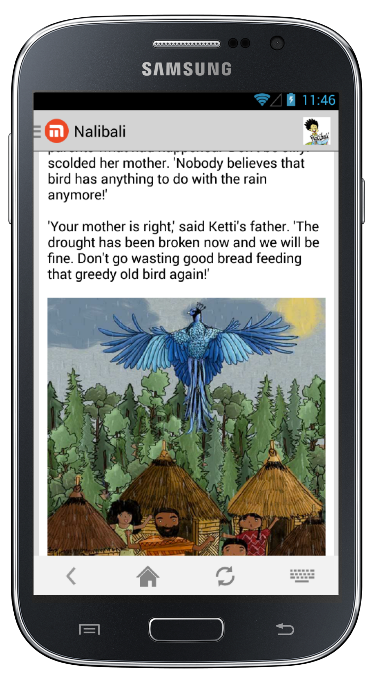Children’s digital publishing in Africa, the Arab World and India
This article was co-published with Takam Tikou, the online journal dedicated to children’s publishing in Africa, the Arab world, the Caribbean and the Indian Ocean (a publication by the National Centre for Children’s Literature – la Joie par les livres, a service provided by the Literature and Art Department of the French National Library).
In the last decade, digital technology has shaken the foundations of the book industry. Children’s publishing has been particularly hard hit: the increasing use of tablets, telephones, e–readers and devices of all kinds by children and teenagers, along with the explosion of mobile applications and other interactive tools have created a new scenario for this sector. In fact, 21% of all children’s books sold in the US are in digital format.
But what is the situation in developing countries? What opportunities, challenges and trends characterize these regions, in terms of electronic publishing? What actors make up the local scene regarding children’s e-books?
Analogue as a challenge, digital as an opportunity
To begin with, it must be noted that, in the countries of the South, traditional publishing has been facing a significant number of challenges for decades. Firstly, printing and paper usually prove to be too expensive, particularly in the children’s books segment, which requires several colours of ink and special types of card. In addition, physical distribution can also become a complex and onerous task. Partly as a result of these factors, in many regions the library network tends to be shaky and poorly stocked.
In this context, digital would appear a priori to be a unique opportunity. Indeed, in electronic modalities the cost of physical materials such as paper is eliminated, at the same time that distribution can be made more efficient. Joanna El Mir, the head of children’s publications at Samir Editeur (Lebanon), weighs up these advantages:
“Like many other publishers, I believe digital could provide a solution to the problem of distribution and the availability of books in the Arab world, beyond national borders. Digital could also contribute to the marketing of books – an area that is too costly at present, especially if a Lebanese publisher tries to find readers at the regional level.”
Specifically, digital technology would make it possible to reach new international markets, for example, readers from the diaspora. In many cases, these are parents who realize that most of the cultural options available are in English, and actively seek out children’s books in their own language.
Multiple obstacles
However, in spite of its great potential, digital publishing in the nations of the South is not free from pitfalls. Firstly, it is undeniable that Internet connection may be deficient, which necessarily discourages the consumption of electronic content. Furthermore, most ordinary people do not have tablets or e-readers, due to the high cost of such devices.
There have in fact been numerous public sector initiatives to reduce the digital divide. However, the provision of devices has often only served to highlight another problem: the desperate lack of digital content. Marie Michèle Razafintsalama, the director of the Prediff publishing house (Madagascar), offers a very concrete example in this regard:
“Since the last quarter of 2014, the Madagascan Ministry of Education has handed out thousands of tablets, but nobody knows exactly what is in them”.
Given this lack of content, one option for local users might be to buy imported e-books. However, these materials can be difficult to get hold of for the local consumer, due to both reasons of price – an e-book selling for $9.99 may be accessible for a reader from the US, but not necessarily for a family in a poor country – as well as limitations related to payment methods and the low level of international credit card use. On top of this, buyers can come up against restrictions associated with the territorial rights of e-books: for example, French readers living outside of France face difficulties when attempting to buy e-books distributed by platforms from that country. In fact, this problem has given rise to a parliamentary debate.
But what about locally published content? What limitations exist in these regions when it comes to producing and distributing digital books for children? In many cases, publishers from the South do not have electronic versions of their own works and do not always possess the necessary know-how to make e-books. Furthermore, creating a fairly complex interactive publication may require an investment that is beyond the reach of an independent publishing house. This problem is compounded by the fact that the available technology is not always adapted to the native context and language.
Finally, while the potential market is huge, the buying public can, in reality, turn out to be quite meagre: in this regard, some of the publishers consulted highlighted the problem of piracy and others, the lack of readers. And with respect to international markets, if the truth be told, it is not easy for independent publishers to obtain good global distribution, either in digital or paper format. Nadia Essalmi, the director of Yomad – the first Moroccan publishing house to specialize in children’s books –, offers a convincing explanation:
“With very few exceptions, Moroccan publishers have no presence on Amazon, a store that accounts for a very high percentage of physical and electronic book sales globally. To begin with, this company does not make physical deliveries in the Arab world. In addition, sellers are forced to operate with a European bank account.”
Fom paper to the e-book: Eppur si muove!
The obstacles to being able to enjoy the benefits of digital are – it is true – considerable, but this has not entirely deterred local publishers, who are implementing all kinds of innovations to overcome these difficulties. For example, the children’s publisher Kalimat (Sharjah) – founded in 2007 by Sheikha Bodour Al Qasimi and internationally renowned for both its printed and digital works – set about building its own software for publishing interactive books. This tool has enabled Kalimat to overcome a number of the limitations posed by standard formats such as EPUB when creating educational and literary e-books in Arabic.
Established in Dakar in 2008, Nouvelles Editions Numériques Africaines (NENA) has published over 125 works by African authors, on different subjects. In April 2014, NENA presented its African Digital Bookstore (LNA, for its French acronym), which currently sells more than 350 digital titles co-published with twenty or so publishers from the region. For the time being, LNA’s supply of children’s books is limited, but according to Marc-André Ledoux – its founder –, the future for the sector looks bright:
“Our digital offerings for children are limited for now to 2 or 3 titles. But I can assure you that my eight year-old daughter really enjoys the bedtime stories that I tell her with my e-reader. The great challenge at present is to convince African publishers to switch to digital. There is a potential for several thousand titles created by African authors and publishers. Imagine the day when all of these titles are gathered together in one place: readers from across the world who are interested in African issues could meet up there and the whole of African literature would be highlighted, instead of getting lost amid the plethora of offerings on Amazon or the iBookStore.”
There are also non-commercial projects that take advantage of technology in original ways. Led by three South African publishers, BookDash organizes “book-making marathons” that attract dozens of volunteers – writers, photographers, illustrators and other artists – to create children’s books of high visual quality. The works are available in PDF for free download and are, so to speak, open source, since BookDash releases the original files –layout and image –, for anyone to read and even to readapt and print out themselves. Arthur Attwell, who founded the initiative, stresses the importance of handing out free books and raising financing through crowdfunding, particularly in view of the income inequalities that characterize his country:
“Market-based solutions seem unable to get off the ground. Where markets should grow from little pockets of early adopters, there may not be enough pockets to grow from. For most South Africans, books are a luxury they could never afford.”

First page of A House for Mouse (Michele Fry, Amy Uzzell and Jennifer Jacobs), BookDash
In a similar vein, the non-profit publishing house Pratham books, based in Bangalore, produces children’s books in paper and digital versions, in several Indian languages and with open licenses: this modality has enabled it to reach an audience of over 52 million readers. Its e-books are available free of charge on Scribd and other online platforms. A number of titles such as Too Much Noise can be read with simultaneous audio and provide complementary multimedia materials.

Cover of the Hindi version of the e-book Too Much Noise (Noni), Pratham Books
The viewing and creation of e-books online – usually with the option of having the text read out loud – is in fact a particularly common trend. Here we could mention four platforms – three Indian and one South African – that offer this service, used extensively by publishers and writers:
Apps and content for mobile devices: an expanding galaxy
In addition to venturing into producing e-books, some children’s book publishers have begun to explore the world of apps – at a time when we are witnessing an unprecedented boom in cell phones. The Jordanian publishing house Al Salwa, which since 1996 has specialized in illustrated children’s books, offers two interesting examples: Adventure on the Farm and Anything. As Salwa Shakhshir, the head of the company, explains, the publication of these applications has provided them with an essential lesson:
“We entered the digital world with keen enthusiasm. We were among the first publishers in the Arab world to publish applications combining stories, games and songs. However, marketing these two materials was not easy and we realized that the return on the investment was not what we were expecting. Thus, in order to reduce costs, we decided to make use of existing applications and stores and to position ourselves as providers of children’s content in Arabic: now we just send them our material and we don’t have to worry about anything other than collecting monthly revenues. This has proved to be the most profitable option.”

The Adventure on the Farm application icon (Al Salwa )
But who is developing these mobile content stores/applications that publishers are gradually turning to? The answer is countless native start-ups that, thanks to their capacity for innovation and particularly to their role as intermediaries for the large platforms such as Apple, Google and Amazon, occupy a growing share of the market for children and teenagers.
There are numerous examples of such ventures from the Arab world. The Lamsa application (Saudi Arabia) allows users to download children’s books; since its launch in 2013, the publications distributed by Lamsa have been viewed over 7.5 million times. For its part, the free application Horoofi Al Arabiya [My Arabic letters], designed by the Jordanian start-up Media Plus in association with BeeLabs, has exceeded 500,000 downloads. Founded in 2008, also in Jordan, Masmoo3 is the first enterprise specializing in digital audiobooks aimed at the Arabic speaking public; it has already produced more than 140 children’s stories.
Other prominent examples can be found in Africa. From its offices in Ghana and Kenya, the video game company LetiArts is producing its collection of digital comics “Africa’s Legends”, designed for cell phones . Meanwhile, in 2014 the Kenyan company AfroKidz created the application Safari Tales, which brings together stories from across the region, adapted to an interactive format. Richard Wanjohi, the company’s marketing director, states:
“By collecting and digitising stories from the various African communities, we are able to capture some narratives that have never been published in books. Very good examples are African nursery rhymes, tongue twisters and songs. Mobile [devices] will enable anyone in the world to gain access to this content as fewer and fewer books are printed.”
In addition to the projects carried out by commercial publishers and start-ups, in the South there are numerous non-profit initiatives that are taking advantage of the accelerated expansion of mobile phones to offer free content. Here we provide two examples from South Africa. FunDza distributes texts from its own mobile network and from the social network MXIT and has over 300,000 monthly readers. In turn, with the aim of promoting reading among children, the organization Nal’ibali – isiXhosa for “here’s the story” – launched its own application, also designed for MXIT, in 2014: within just a few months it exceeded 120,000 subscribers.

The English version of the story The rain bird, viewed on the Nal’ibali application
A glance towards the future
Digital publishing for children and teens in the countries of the South presents a highly diverse scenario, in which the different actors approach new technologies in their own way. In the case of “traditional” publishers, the emphasis is placed on exploring digital, but without harming sales of printed books. For non-profit projects, it is a question of using the power of these technologies – mainly mobile phones – to reach the masses, efficiently and economically. Finally, start-ups are taking advantage of interactive tools and the very scale of the Web to distribute new types of content.
Although there are enormous differences between regions – and even within each region –, the general trend seems to point towards increasing digitization. Indeed, in spite of infrastructure limitations, readers and authors are already changing their practices, in particular due to the impact of mobile phones. The public sector, for its part, is investing in devices, mainly in the education sector, which is having a direct impact on young people’s habits. The conditions are thus ripe for a rapid advance in digital publishing for children and teens, albeit in forms that do not necessarily recreate the path taken by the industry in the US or Europe.
Local publishers could be the leading players in this great transition, insofar as they are able to establish exchanges with the dynamic world of start-ups and with the original projects carried out by non-profit institutions. This rich ecosystem might give birth to the future industry of digital books for children and teens in the South.
Bibliography
A. Attwell (2014), “In South Africa, Crowd-sourced Publishing Tackles Book Poverty“, Publishing Perspectives.
O. Kulesz (2011), L’Édition numérique dans les pays en développement, Alliance internationale des éditeurs indépendants.
O. Kulesz (2014), “Édition jeunesse numérique dans le monde arabe : entretien avec Lina Said et Tamer Said (Kalimat)“, in Alliance-Lab.
G. Mulligan (2014), “Kenyan startup provides African children’s stories through mobile“, Humanipo.
M. Rahal (2014), “Twofour54 and Lamsa: a partnership to support Arabic content for children“,Wamda.
T. Risen (2014), “Internet Users Boom to Nearly 3 Billion as Mobile Expands“, USNews.
B. Stauffer (2013), “Children’s Publishers: Game Changers in the Forefront“, Al Kitab Al Arabi.
S. Vosloo (2010), “It’s about reading, not paper vs pixels“.

